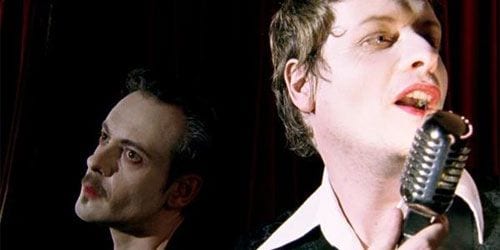
The Real Tuesday Weld’s The End of the World is designed to recall something like that scene in David Lynch’s film Mulholland Drive, where the possibly still-dreaming protagonist is led in the middle of the night to a strange nightclub, where an odd performance unexpectedly stirs up deep feelings. The End of the World Bar could be that nightclub, complete with thick red stage curtains and shadows. In the liner notes, Stephen Coates, aka the Real Tuesday Weld, aka the Clerkenwell Kid, writes a brief narrative of dreamlike confusion, setting up a similar story of being taken somewhere strange yet somehow familiar:
You are crying and laughing again and you still don’t know why. The singer beckons you up onto the stage. He passes you the microphone and you start to sing without hesitation, “…And I get the most peculiar feeling, you’ve been dreaming too…”
The End of the World is ostensibly a live album recorded at this strange place, The End of the World Bar in London, on Valentine’s Eve, 2008. It’s a bar I’m fairly certain does not exist, and an album I’m equally sure was released in some limited-edition form before its supposed recording date, as an accompaniment of some copies of the last Real Tuesday Weld album, 2007’s The London Book of the Dead. That place/time confusion is appropriate for the feeling of the album, that sense that you’ve been here before but haven’t, that something important is happening though on the surface things are ordinary, that the world might be ending outside though the performance itself hardly betrays it.
That feeling comes in part from the way the album does and does not resemble a live recording. There is an MC introducing the performer. Coates banters with the crowd between songs. The crowd applauds. Yet the crowd doesn’t sound “real” and the recording doesn’t sound “live”. The MC seems to be hiding something: “I hope you’re all comfortable, for this last evening’s performance.” The cocktail jazz that plays behind his introduction holds within it faint hints of an air-raid siren and demons’ growls. The first song played is a slow-motion version of the standard “I’ll See You in My Dreams”, its title a tell-tale clue. Coates sings it splendidly, the sensitive crooner. Yet the straightforward vocal take contrasts with the surreal setting in a way that can’t help but recall Jimmy Scott singing in the Twin Peaks finale or Roy Orbison on the Blue Velvet soundtrack. The moody songs that comes next, “Epitaph for a Dream”, is in the style of Tom Waits’ Franks Wild Years, right from the opening notes. When Coates starts singing, it seems more a proper ballad for a moment, but keeps getting more abstract.
That Lynch/Waits strange ordinariness, or ordinary strangeness, is the musical setting for the album. Within it Coates sings both jazzy love ballads and odder mood pieces. The atmosphere is as romantic as it is odd, and some of the love ballads are beautiful enough to imagine Coates could have a career as a present-day reincarnation of Chet Baker. “Over the Hillsides” is perhaps the loveliest song, and one that exemplifies most the crossroads between the love-ballad form and the confusion of a dream-state. He sings lyrics like, “And you’ll grow old and wonder if I was a dream that you had once upon a time”, as someone softly yodels in the background. The piano-driven “What It Takes” is another stunner, with less of an obvious dreamer’s slant. As the song picks up speed, the trumpet player steps up for a solo, while Coates sings in a whisper.
It’s one of several songs on the album that showcase the band behind Coates, seemingly a refined jazz quintet. Their sound is in contrast to the other Real Tuesday Weld albums, where Coates the one-man-band would place layer upon layer upon layer. Though here it sounds like he’s up on stage performing with just a few other musicians, I’m not convinced that his process wasn’t similar to his usual. There are weird background touches throughout that bring the live-band format into question. Beneath the surface everything sounds carefully planned and arranged. Importantly, though, the album sounds like it was performed by a small group in an unadorned live setting. It still ends up resembling a more stripped-down intimate Real Tuesday Weld album. It shares the central theme of his other albums — love and death — but the romantic side aims more directly at the heart, while the otherworldliness is accentuated by the simplicity of it all. As a live album, real or imaginary, it seems less “substantial” than the other Real Tuesday Weld albums, but it wears that stature well. The fulfillment of smaller ambitions makes it more satisfying and intriguing, in some ways the most successful Real Tuesday Weld album yet.

![Call for Papers: All Things Reconsidered [MUSIC] May-August 2024](https://www.popmatters.com/wp-content/uploads/2024/04/all-things-reconsidered-call-music-may-2024-720x380.jpg)



